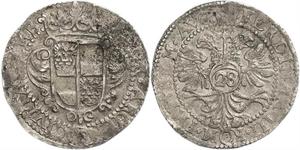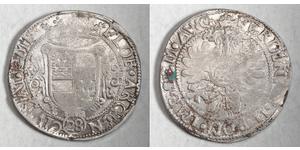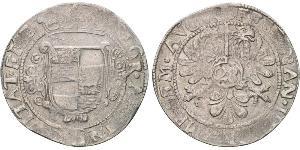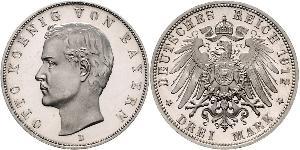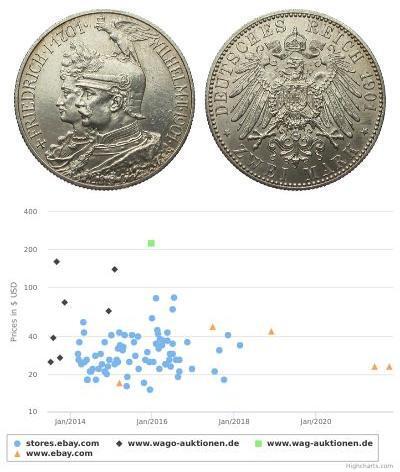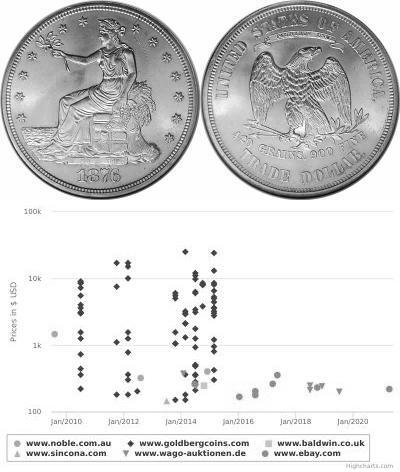2/3 Thaler Germany Silver Ferdinand II, Holy Roman Emperor (1578 ...
1624-1637, Emden (City), Ferdinand II. Large Silver 2/3 Thaler (Gulden) Coin.
Mint Year: 1624-1637
Mint Place: Emden (City)
Denomination: 2/3 Thaler (Gulden)
Reference: Davenport 508, KM-10.2.
Weight: 19.76gm
Diameter: 41mm
Material: Silver
Obverse: Crowned arms of Emden within foliage. Value numeral in stuber (28) splitting legend below.
Legend: FLOR . ARGEN (28) CIVITAT . EMB
Reverse: Crown above double headed eagle with cross-topped orb at chest, which contains value numeral in stuber (28).
Legend: FERDINAN . II . ROM . IMP . SEM . AVG
Emden is a town and seaport in Lower Saxony in the northwest of Germany, on the river Ems. It is the main town of the region of East Frisia and, in 2011, had a total population of 51,528. The exact founding date of Emden is unknown, but it has existed at least since the 8th century. Older names for Emden are Amuthon, Embda, Emda, and Embden. Town privilege and the town’s coat of arms, the Engelke up de Muer (The Little Angel on the Wall) was granted by Emperor Maximilian I in 1495. In the 16th century, Emden briefly became an important centre for the Protestant Reformation under the rule of Countess Anna von Oldenburg who was determined to find a religious “third way” between Lutheranism and Catholicism. In 1542 she invited the Polish noble John Laski (or Joahannes a Lasco) to become pastor of a Protestant church at Emden; :xi and for 7 years he continued to spread the new religion around the area of East Frisia. However, in 1549 following pressure from the Emperor Charles V, the Countess was forced to ask Laski to leave for England and the experiment came to an end. Nevertheless, the legacy was important for the reformation in the Netherlands. Emden was a very rich town during the 17th century, due to large numbers of Dutch immigrants such as Diederik Jansz. Graeff. It was a centre of reformed Protestantism at that time, producing the first Bible translation in Dutch. The Emden Revolution in 1595 resulted in Emden becoming a distinct city-state. The political theorist Johannes Althusius served as Syndic from 1604 to 1638. :xii In 1744 Emden was annexed by Prussia. In 1752 Frederick the Great chartered the Emden Company to trade with Canton, but the company was ruined when Emden was captured by French forces in 1757 during the Seven Years' War. The town was recaptured by Anglo-German forces in 1758 and for the rest of the conflict was used as a major supply base by the British to support the ongoing war in Westphalia. During the Napoleonic French era, Emden and the surrounding lands of East Frisia were part of the short-lived Kingdom of Holland. Industrialization started at around 1870, with a paper mill and a somewhat bigger shipyard. At the end of the 19th century, a big canal, the Dortmund-Ems Canal was constructed, which connected Emden with the Ruhr area. This made Emden the “seaport of the Ruhr area”, which lasted until the 1970s. Coal from the south was transported to the North Sea port, and imported iron ore was shipped via the canal towards Rhine and the Ruhr. The last iron ore freighter was moored in the port of Emden in 1986. In 1903, a large shipyard (Nordseewerke, “North Sea Works”) was founded which still exists today. The town centre was almost completely wiped out as a result of Allied bombing raids during the Second World War, destroying nearly all historic buildings. The RAF first bombed Emden on 31 March 1940. The most severe bombing took place on 6 September 1944, when roughly 80 percent of all houses in the town centre were destroyed. In the collective memory of the town, this date still plays an important role. The shipyard area was largely untouched – the British targeted the civilian areas, apparently in revenge for the bombing of Coventry by the Luftwaffe.[citation needed] The reconstructed town was opened on 6 September 1962, exactly 18 years after the bombing.
Ferdinand II, Holy Roman Emperor (July 9, 1578 – February 15, 1637), of the House of Habsburg, reigned as Holy Roman Emperor from 1619-1637. He was also the Archduke of Styria (Inner Austria) from 1590–1637, King of Bohemia from 1617-1619 and again from 1620-1637, as well as King of Hungary from 1618-1625. A devout Catholic, his recognition as King of Bohemia and suppression of Protestantism precipitated the early events of the Thirty Years' War. The duration of his reign was occupied by confessional and military concerns.
Born in Graz to Charles II of Austria (1540-1590) and Maria Anna of Bavaria (1551-1608), Ferdinand was provided with a strict Jesuit education culminating in his years at the University of Ingolstadt. After completing his studies in 1595, he acceded to his hereditary lands (where his older cousin Archduke Maximilian III of Austria had acted as his regent 1593-95) and made a pilgrimage to Loreto and Rome. Shortly afterwards, he began to suppress the practice of non-Catholic faiths within his territory.
In 1617, Ferdinand was elected King of Bohemia by the Bohemian Diet. He also secured support from the Spanish Habsburgs for his claim to succeed the childless Emperor Matthias on the throne, granting them future rule over Alsace and Imperial fiefs in Italy. Ferdinand’s staunch Catholicism led to infringements on the religious freedoms of non-Catholics. Among other things, the king did not respect the religious freedoms granted in the Majestät (or “Majestic Letter”) signed by the earlier emperor Rudolf II to end the Brothers' War, which had granted freedom of worship to nobles and the inhabitants of cities. Additionally, Ferdinand was an absolutist and infringed upon what nobles regarded as secular rights. Given the relatively large number of Protestants within the kingdom, including many among the noble classes, the new king soon became unpopular and some dissidents participated in the ensuing Bohemian Revolt. On May 22, 1618, two royal (Catholic) officials in Prague were thrown out a castle window by Bohemian Protestants (the Defenestration of Prague). Though the officials were uninjured, such actions did not fall within the realm of standard protocol, and the clear offense against the royal dignity led to a hardening of attitudes and full rebellion.
The nobility revolted against Ferdinand and replaced him with the Protestant Elector Frederick V of the Palatinate, known as the "Winter King."
Emperor Matthias died in Vienna in March 1619. As earlier agreed, Ferdinand succeeded him on the throne. Supported by the Catholic League, which included the rulers of Poland, Spain, and Bavaria, Ferdinand sought to reclaim his Bohemian possessions and stamp out the Protestant rebellion. On November 8, 1620, Catholic forces engaged those supporting the Protestant Frederick, who had taken the Bohemian kingship, at the Battle of White Mountain. After only two hours of fighting, the Catholics emerged victorious. The now-deposed Frederick fled to the Netherlands and Duke Maximilian I of Bavaria, the leader of the Catholic League, moved to confiscate his lands in the Palatinate. The restored Ferdinand set about strengthening the Catholic church in Bohemia, reduced the authority of the Diet, and forcibly converted Austrian and Bohemian Protestants.
By 1625, despite receiving subsidies from the Spanish and the Pope, Ferdinand was strapped for cash and looking for a means to raise his own army. His solution was to charge the Bohemian soldier and “military entrepreneur” Albrecht von Wallenstein with raising and commanding an Imperial army. Wallenstein accepted the position with the proviso that the management (and possession) of the army’s funds were solely his, as was the right to take and distribute loot and ransoms taken in the course of operations. Quickly raising at least 30,000 men (he would later command at least 100,000), and fighting alongside the Catholic League army under the Count of Tilly, Wallenstein defeated Protestant forces in Silesia, Anhalt, and Denmark.
With his forces scoring important victories against the Protestants, Ferdinand crowned his religious policies by issuing his Edict of Restitution (1629), which was designed to restore all ecclesiastical properties which had been secularized since the Peace of Passau in 1552. This blatantly pro-Catholic policy has been widely credited with bringing the Protestant King of Sweden, Gustavus Adolphus, into the war against Ferdinand.
Despite the successes of Wallenstein, many of Ferdinand’s advisors saw a genuine political threat in the general, citing his growing influence, his increasing number of estates and titles, as well as his extortionate methods of raising funds for his army. Ferdinand responded by dismissing Wallenstein in 1630. With the loss of his commander, he was once again forced to rely on the Catholic League army under Tilly, who was unable to stem the Swedish advance and was killed in 1632. As a result, Ferdinand recalled Wallenstein from retirement.
In the spring of 1632, Wallenstein raised a fresh army in a matter of weeks and drove the Protestant army out of Bohemia. In November came the great Battle of Lützen, at which the Catholics were defeated, but Gustavus Adolphus was killed. Wallenstein withdrew to winter quarters in Bohemia. Although he had lost strategically and been forced out of Saxony, the Protestants had suffered much greater casualties.
The campaigning of 1633 was indecisive, partly because Wallenstein was negotiating with the enemy, thinking that the army would be loyal to him, rather than Ferdinand, and follow him if he switched sides. In early 1634, he was openly accused of treason and assassinated at Eger, probably at Ferdinand’s instigation.
Despite the loss of Wallenstein, Imperial forces took Regensburg and won a victory at the Battle of Nördlingen. Swedish strength was greatly weakened, but France entered the war on the side of the Protestants out of fear of Habsburg domination. Although the country was Catholic, France feared both the Germans and the Spanish, so Cardinal Richelieu convinced King Louis XIII of France to ally himself with the Dutch and the Swedes.
The French were highly dissatisfied with the terms of the Peace of Prague concluded in 1635, the last important act of Ferdinand. Therefore, although a treaty was signed, peace did not come. At Ferdinand’s death in 1637, his son Ferdinand III inherited an embattled empire.
1624, Emden (City), Ferdinand II. Silver 28 Stuber (2/3 Thaler = Gulden) Coin.
Mint Year: 1624-1637 Mint Place: Emden (City) Reference: Davenport 507, KM-10. Denomination: 28 Stuber (2/3 Thaler = 1 Gulden) Condition: Light weakness of strike and a few old scratches in obverse, otherwise a handsome specimen, appartently struck on a broad and almost fully round planchet! Weight: 20.32gm Diameter: 40mm Material: Silver
Obverse: Crowned arms of Emden (Harpiye in 2nd and 4th square) within foliage. Two rosettes above. Stuber value (28) below. Legend: FLOR . ARGEN (28) CIVITAT . EMB Reverse: Crown above double headed eagle with cross-topped orb at chest, which contains stuber value (28). Legend: FERDINAN . II . ROM . IMP . SEM . AVGV
Emden is a town and seaport in Lower Saxony in the northwest of Germany, on the river Ems. It is the main town of the region of East Frisia and, in 2011, had a total population of 51,528. The exact founding date of Emden is unknown, but it has existed at least since the 8th century. Older names for Emden are Amuthon, Embda, Emda, and Embden. Town privilege and the town’s coat of arms, the Engelke up de Muer (The Little Angel on the Wall) was granted by Emperor Maximilian I in 1495. In the 16th century, Emden briefly became an important centre for the Protestant Reformation under the rule of Countess Anna von Oldenburg who was determined to find a religious “third way” between Lutheranism and Catholicism. In 1542 she invited the Polish noble John Laski (or Joahannes a Lasco) to become pastor of a Protestant church at Emden; :xi and for 7 years he continued to spread the new religion around the area of East Frisia. However, in 1549 following pressure from the Emperor Charles V, the Countess was forced to ask Laski to leave for England and the experiment came to an end. Nevertheless, the legacy was important for the reformation in the Netherlands. Emden was a very rich town during the 17th century, due to large numbers of Dutch immigrants such as Diederik Jansz. Graeff. It was a centre of reformed Protestantism at that time, producing the first Bible translation in Dutch. The Emden Revolution in 1595 resulted in Emden becoming a distinct city-state. The political theorist Johannes Althusius served as Syndic from 1604 to 1638. :xii In 1744 Emden was annexed by Prussia. In 1752 Frederick the Great chartered the Emden Company to trade with Canton, but the company was ruined when Emden was captured by French forces in 1757 during the Seven Years' War. The town was recaptured by Anglo-German forces in 1758 and for the rest of the conflict was used as a major supply base by the British to support the ongoing war in Westphalia. During the Napoleonic French era, Emden and the surrounding lands of East Frisia were part of the short-lived Kingdom of Holland. Industrialization started at around 1870, with a paper mill and a somewhat bigger shipyard. At the end of the 19th century, a big canal, the Dortmund-Ems Canal was constructed, which connected Emden with the Ruhr area. This made Emden the “seaport of the Ruhr area”, which lasted until the 1970s. Coal from the south was transported to the North Sea port, and imported iron ore was shipped via the canal towards Rhine and the Ruhr. The last iron ore freighter was moored in the port of Emden in 1986. In 1903, a large shipyard (Nordseewerke, “North Sea Works”) was founded which still exists today. The town centre was almost completely wiped out as a result of Allied bombing raids during the Second World War, destroying nearly all historic buildings. The RAF first bombed Emden on 31 March 1940. The most severe bombing took place on 6 September 1944, when roughly 80 percent of all houses in the town centre were destroyed. In the collective memory of the town, this date still plays an important role. The shipyard area was largely untouched – the British targeted the civilian areas, apparently in revenge for the bombing of Coventry by the Luftwaffe.[citation needed] The reconstructed town was opened on 6 September 1962, exactly 18 years after the bombing.
Ferdinand II, Holy Roman Emperor (July 9, 1578 – February 15, 1637), of the House of Habsburg, reigned as Holy Roman Emperor from 1619-1637. He was also the Archduke of Styria (Inner Austria) from 1590–1637, King of Bohemia from 1617-1619 and again from 1620-1637, as well as King of Hungary from 1618-1625. A devout Catholic, his recognition as King of Bohemia and suppression of Protestantism precipitated the early events of the Thirty Years' War. The duration of his reign was occupied by confessional and military concerns.
Born in Graz to Charles II of Austria (1540-1590) and Maria Anna of Bavaria (1551-1608), Ferdinand was provided with a strict Jesuit education culminating in his years at the University of Ingolstadt. After completing his studies in 1595, he acceded to his hereditary lands (where his older cousin Archduke Maximilian III of Austria had acted as his regent 1593-95) and made a pilgrimage to Loreto and Rome. Shortly afterwards, he began to suppress the practice of non-Catholic faiths within his territory.
In 1617, Ferdinand was elected King of Bohemia by the Bohemian Diet. He also secured support from the Spanish Habsburgs for his claim to succeed the childless Emperor Matthias on the throne, granting them future rule over Alsace and Imperial fiefs in Italy. Ferdinand’s staunch Catholicism led to infringements on the religious freedoms of non-Catholics. Among other things, the king did not respect the religious freedoms granted in the Majestät (or “Majestic Letter”) signed by the earlier emperor Rudolf II to end the Brothers' War, which had granted freedom of worship to nobles and the inhabitants of cities. Additionally, Ferdinand was an absolutist and infringed upon what nobles regarded as secular rights. Given the relatively large number of Protestants within the kingdom, including many among the noble classes, the new king soon became unpopular and some dissidents participated in the ensuing Bohemian Revolt. On May 22, 1618, two royal (Catholic) officials in Prague were thrown out a castle window by Bohemian Protestants (the Defenestration of Prague). Though the officials were uninjured, such actions did not fall within the realm of standard protocol, and the clear offense against the royal dignity led to a hardening of attitudes and full rebellion.
The nobility revolted against Ferdinand and replaced him with the Protestant Elector Frederick V of the Palatinate, known as the "Winter King."
Emperor Matthias died in Vienna in March 1619. As earlier agreed, Ferdinand succeeded him on the throne. Supported by the Catholic League, which included the rulers of Poland, Spain, and Bavaria, Ferdinand sought to reclaim his Bohemian possessions and stamp out the Protestant rebellion. On November 8, 1620, Catholic forces engaged those supporting the Protestant Frederick, who had taken the Bohemian kingship, at the Battle of White Mountain. After only two hours of fighting, the Catholics emerged victorious. The now-deposed Frederick fled to the Netherlands and Duke Maximilian I of Bavaria, the leader of the Catholic League, moved to confiscate his lands in the Palatinate. The restored Ferdinand set about strengthening the Catholic church in Bohemia, reduced the authority of the Diet, and forcibly converted Austrian and Bohemian Protestants.
By 1625, despite receiving subsidies from the Spanish and the Pope, Ferdinand was strapped for cash and looking for a means to raise his own army. His solution was to charge the Bohemian soldier and “military entrepreneur” Albrecht von Wallenstein with raising and commanding an Imperial army. Wallenstein accepted the position with the proviso that the management (and possession) of the army’s funds were solely his, as was the right to take and distribute loot and ransoms taken in the course of operations. Quickly raising at least 30,000 men (he would later command at least 100,000), and fighting alongside the Catholic League army under the Count of Tilly, Wallenstein defeated Protestant forces in Silesia, Anhalt, and Denmark.
With his forces scoring important victories against the Protestants, Ferdinand crowned his religious policies by issuing his Edict of Restitution (1629), which was designed to restore all ecclesiastical properties which had been secularized since the Peace of Passau in 1552. This blatantly pro-Catholic policy has been widely credited with bringing the Protestant King of Sweden, Gustavus Adolphus, into the war against Ferdinand.
Despite the successes of Wallenstein, many of Ferdinand’s advisors saw a genuine political threat in the general, citing his growing influence, his increasing number of estates and titles, as well as his extortionate methods of raising funds for his army. Ferdinand responded by dismissing Wallenstein in 1630. With the loss of his commander, he was once again forced to rely on the Catholic League army under Tilly, who was unable to stem the Swedish advance and was killed in 1632. As a result, Ferdinand recalled Wallenstein from retirement.
In the spring of 1632, Wallenstein raised a fresh army in a matter of weeks and drove the Protestant army out of Bohemia. In November came the great Battle of Lützen, at which the Catholics were defeated, but Gustavus Adolphus was killed. Wallenstein withdrew to winter quarters in Bohemia. Although he had lost strategically and been forced out of Saxony, the Protestants had suffered much greater casualties.
The campaigning of 1633 was indecisive, partly because Wallenstein was negotiating with the enemy, thinking that the army would be loyal to him, rather than Ferdinand, and follow him if he switched sides. In early 1634, he was openly accused of treason and assassinated at Eger, probably at Ferdinand’s instigation.
Despite the loss of Wallenstein, Imperial forces took Regensburg and won a victory at the Battle of Nördlingen. Swedish strength was greatly weakened, but France entered the war on the side of the Protestants out of fear of Habsburg domination. Although the country was Catholic, France feared both the Germans and the Spanish, so Cardinal Richelieu convinced King Louis XIII of France to ally himself with the Dutch and the Swedes.
The French were highly dissatisfied with the terms of the Peace of Prague concluded in 1635, the last important act of Ferdinand. Therefore, although a treaty was signed, peace did not come. At Ferdinand’s death in 1637, his son Ferdinand III inherited an embattled empire.
| 1 | 2 |
|---|
(1500 X 753 pixels, file size: ~211K)
Posted by: anonymous 2017-12-15
Emden, StadtGulden zu 28 Stübern o.J. Mit Namen und Titel Ferdinands III. Gekröntes Wappen / Reichsadler mit Wertzahl 28 auf der Brust. Davenport 508. Sehr schön +
(1365 X 648 pixels, file size: ~210K)
Posted by: anonymous 2017-07-28
1637, Emden City, Ferdinand III. Silver 2/3 Thaler (28 Stuber = 1 Gulden) Coin. Mint year: 1624-1637 Mint Place: Emden (City) Condition: A crudely struck VF! Reference: Davenport 508, KM-16. Denomination: 2/3 Thaler (28 Stuber = 1 Gulden) Weight: 19.14gm Diameter: 41mm Material: ...
(3205 X 1529 pixels, file size: ~1M)
Posted by: anonymous 2023-12-07
Untitled Document 1624-1637, Emden (City), Ferdinand II. Large Silver 2/3 Thaler (Gulden) Coin. Mint Year: 1624-1637 Mint Place: Emden (City) Denomination: 2/3 Thaler (Gulden) Reference: Davenport 508, KM-10.2. Condition: Crudely struck and with weak details due to an uneven ...
(900 X 454 pixels, file size: ~120K)
Posted by: anonymous 2015-11-28
Emden, Stadt Gulden zu 28 Stübern o.J. Mit Titel Ferdinands III. Gekröntes Wappen / Reichsadler mit Wertzahl 28 auf der Brust. Davenport 508. Übliche Prägeschwäche, sehr schön
(800 X 394 pixels, file size: ~102K)
Posted by: anonymous 2015-08-28
GERMANY. Emden. Ferdinand III (1637-53). 28 Stueber (Gulden). Obv: FERDINAN III ROM IMP SEM AVG. Imperial eagle with globe cruciger on breast. Rev: FLOR ARGEN CIVITAT EMB. Crowned coat of arms. Davenport 508. Condition: Very fine. Weight: 19.47 g. Diameter: 41 mm.
(800 X 389 pixels, file size: ~100K)
Posted by: anonymous 2015-08-28
GERMANY. Emden. Ferdinand III (1637-53). 28 Stueber (Gulden). Obv: FERDINAN III ROM IMP SEM AVG. Imperial eagle with globe cruciger on breast. Rev: FLOR ARGEN CIVITAT EMB. Crowned coat of arms. Davenport 508. Condition: Very fine. Weight: 20.00 g. Diameter: 40 mm.


